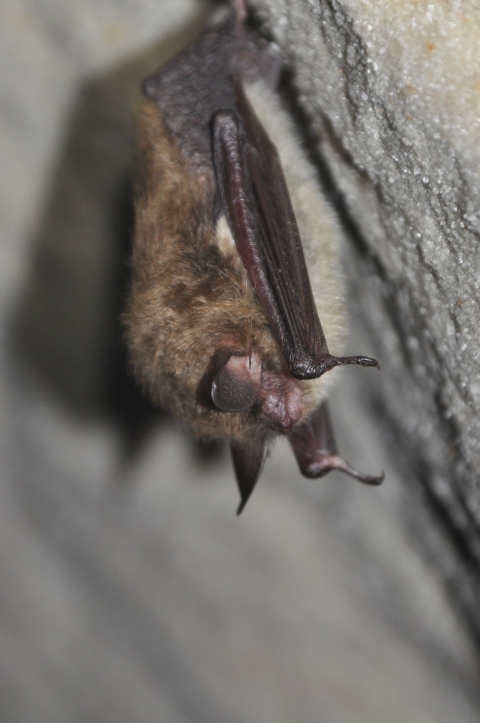Bat species in Minnesota
Minnesota has eight different species of bats: eastern red bat (Lasiurus borealis), hoary bat (Lasiurus cinereus), silver-haired bat (Lasionycteris noctivagans), big brown bat (Eptesicus fuscus), little brown myotis (Myotis lucifugus), northern long-eared bat (Myotis septentrionalis), tricolored bat (Perimyotis subflavus) and the newest addition to the family, the evening bat (Nycticeius humeralis). While these species each weigh less than one ounce, the weight of a pencil, they are an essential part of Minnesota’s ecosystem. Additionally, all bats in Minnesota are insectivorous and eat up to their own body weight in bugs, including beetles, moths and a well-known favorite, mosquitos! Bats are so adept at eating insects, that they save farmers an estimated $3 billion dollars worth of insect control in the United States annually. Bats are nocturnal, or active only at night, and they use something called echolocation in which they send out supersonic sounds to locate food or avoid objects in their flight path. They then use their cupped tail to scoop up the located insects from their path into their mouth. Their diet makes them an important part of Minnesota’s ecosystem.
Once insects are no longer available in the fall, bat species in Minnesota either start their migration south or hibernate for the winter. The eastern red bat, evening bat, hoary bat and silver-haired bat migrate to warmer climates in southern parts of the United States or even as far as South America. The big brown bat, little brown myotis, northern long-eared bat and tricolored bat stick around, spending the winter in caves or mines where they hibernate. In recent years, Minnesota’s cave-dwelling bat populations have declined due to a disease called white-nose syndrome.
White-nose syndrome
White-nose syndrome (WNS) is a disease caused by the fungus, Pseudogymnoascus destructans (or Pd), which has the most drastic effect on cave-dwelling bats such as tricolored bat, little brown bat and northern long-eared bat. This fungus is able to thrive in cold damp places where bats hibernate, even if bats are not present. The spores can survive on clothing, equipment and surfaces within caves or mines for a long period of time. The fungus can be spread by bats due to their highly mobile nature, but also by humans accidentally on equipment or clothing. The name white-nose syndrome comes from the fungus’ appearance on affected bats as a white, fuzzy fungi that grows on the bare skin on and around their nose, but it can actually infect all their skin, which also includes their ears, tails and wings. As the amount of fungus on the bat increases while it is hibernating, it further invades the skin and results in increased body temperature. This, in turn, wakes the bat out of its natural state of hibernation. Once bats are prematurely active, they tend to quickly lose the fat that was intended to last them throughout the whole winter and are left with little to no energy to survive until they can find food in the spring.
White-nose syndrome was first spotted in the United States near Albany, New York in 2006. The first case of white-nose syndrome in Minnesota was found in 2016 at the Forestville/Mystery Cave State Park. Following that discovery, the population of bats hibernating at that location declined by 90%. This disease has spread across most of the United States, affecting millions of bats. Estimates show that within 15 years, a little over half of the species native to North America will be affected by white-nose syndrome and will be at risk for dramatic decline in their populations.
What can you do to help?
The primary way white-nose syndrome spreads is through bat-to-bat contact. Luckily, there are still a few things humans can do to help slow down the spread of white-nose syndrome to preserve Minnesota’s native bat populations:
- Avoid entering caves that have closures or are gated. The spores of Pd, the fungus, last a long time on surfaces, including the walls and floors of caves and mines. Therefore, it is vitally important to wash any gear, equipment, shoes and clothes that may have come in contact with these surfaces, to avoid spreading the fungus. Staying out of caves and bat habitats is helpful to ensure we do not disturb bats during hibernation, when they are already undergoing stress due to disease, a changing climate and habitat loss.
- Create or enhance habitat on your property for bats! Bats need space, shelter, food and water. Allowing large trees to grow in your yard, as well as keeping standing dead trees around helps to create cavities and holes for bats to roost or hide in. Leaving leaf litter and planting native prairie plants will increase the number of nocturnal insects, providing a great food source for the bats. Lastly, you may opt to create a water feature or small wetland, which will give the bats a source of water.
- Be observant and learn more about these not so "spooky" creatures. By November, bats should be entering hibernation, so be on the lookout for any strange activity such as bats flying during the day, looking like they are sick or injured or flying during day or night over the winter months. If you spot any unusual behavior, please report it to the Bat Observation Report on the Minnesota Department of Natural Resources. To learn more about bats (or take advantage of an exciting opportunity to see live bats), Minnesota Valley National Wildlife Refuge is hosting a free public event, Minnesota Bat Festival, on October 26th from 10:00 a.m. - 3:00 p.m. at the Bloomington Education and Visitor Center: 3815 American Blvd. E Bloomington, 55425 MN.
- To learn more about this disease, visit the white-nose syndrome response team website.
If you are looking for additional fall or spooky activities, checkout out the events page on our website!






